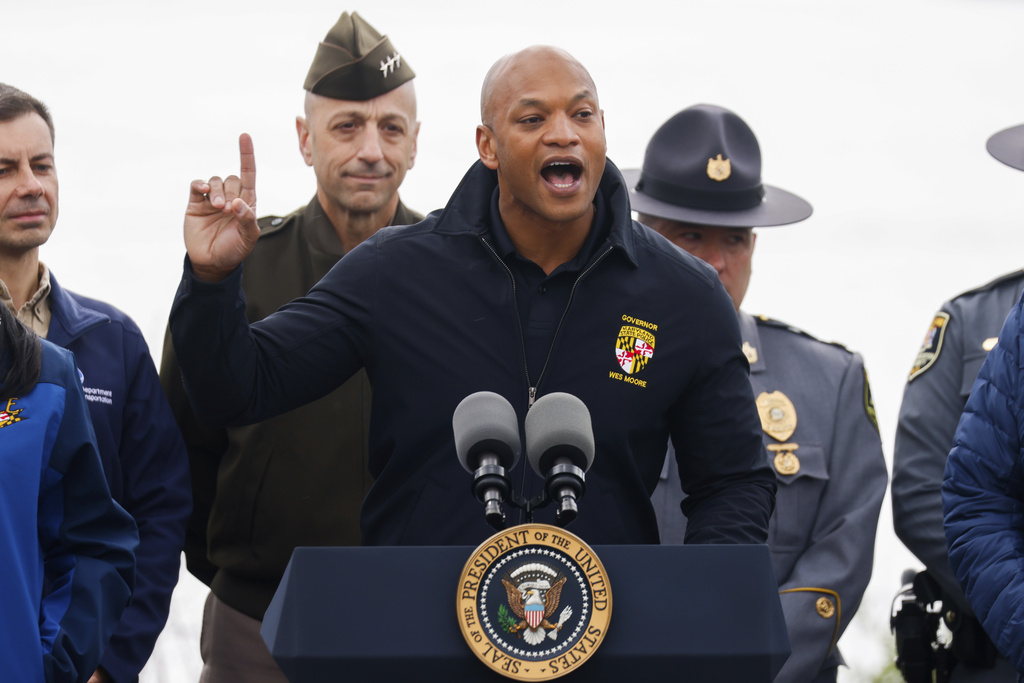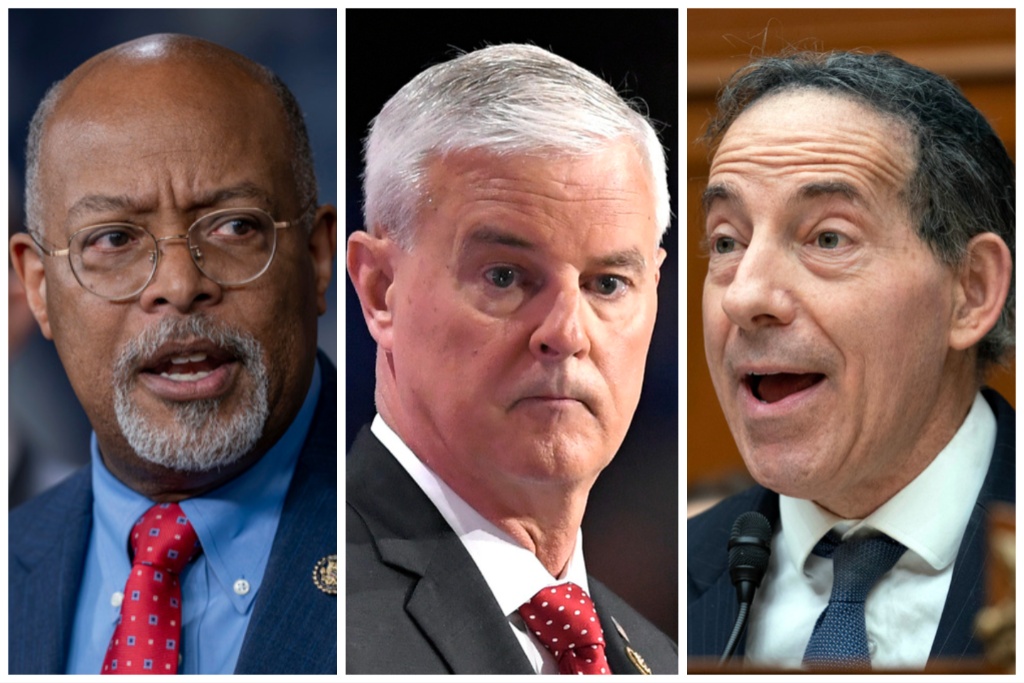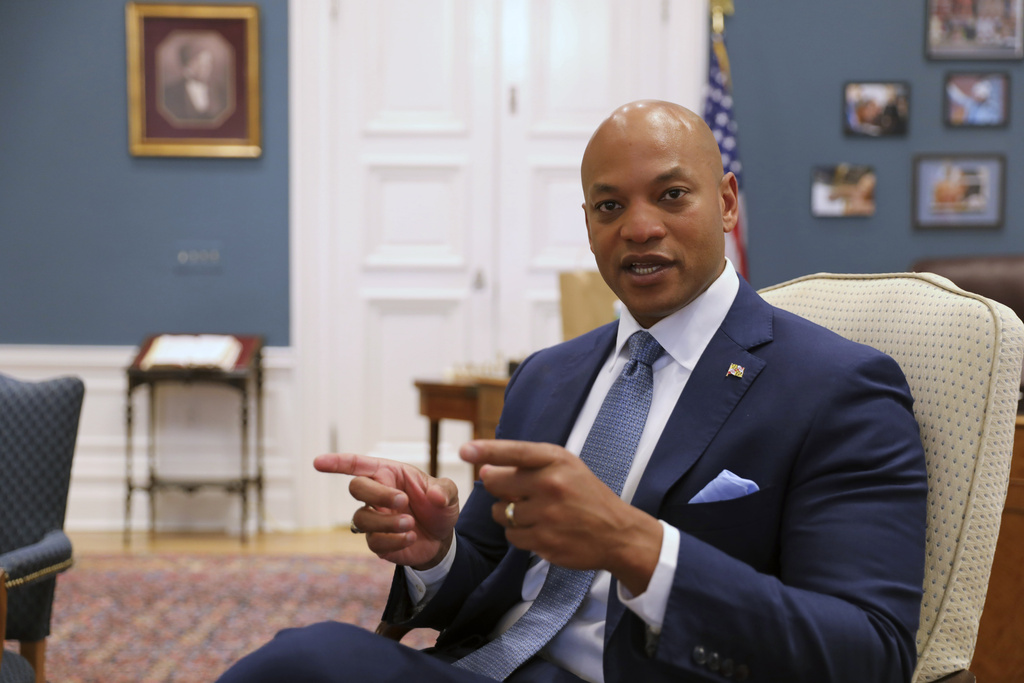
Deep-blue Maryland has been a stronghold for Democrats in general elections for decades. But with a popular former Republican governor running for an open Senate seat and eight House races, the Old Line State could spring a few surprises this November. In this series, Old Line, New Battles: Maryland feels the primary pinch, the Washington Examiner will look at the key figures and important issues six months until Election Day. Part six will look at Gov. Wes Moore’s (D-MD) rising status in the Democratic party.
An infrastructure tragedy in Baltimore has tested the mettle of Gov. Wes Moore (D-MD) and catapulted the rising Democratic star into the national spotlight.
Moore, who hadn’t held elected office until becoming Maryland’s governor in 2023, does not come from political roots, but lately, Democrats are eyeing him with interest as a potential future star of the party.
But, during an interview with the Washington Examiner, Moore said he has no plans for higher office because of the current work he is doing for the Old Line State.
“It’s something that isn’t even partially on my mind, because I honestly feel like I’m living a dream right now,” said Moore, an author, veteran, and former non-profit CEO.
“I feel like I’m playing with house money right now,” the governor quipped.
He noted his upbringing: being raised by a single immigrant mother and having “handcuffs on my wrists at 11 years old,” referring to the time he was put in the back of a police car for tagging walls with graffiti.
Moore recalled that he “was sent away when I was 13, joined the Army at 17, went to a two-year college, and now I’m serving as the governor of Maryland.”
Moore’s upbringing has been central to his rise as a political figure. But Moore, a political newcomer, has also had to address questions about his past after criticism rose during his 2022 run for governor that he had let a narrative grow that he was raised in Baltimore, despite the fact he was born in Takoma Park, Maryland, and spent a portion of his childhood in the Bronx.
Moore rebuked the criticism at the time, saying he did “not think I misled the public at all,” in a statement to a local outlet.
Now, as the governor of the Old Line State, Moore’s name ID has only grown in the aftermath of the collapse of the Francis Scott Key Bridge.

Bridge collapse brings Moore front and center
Moore was thrust into a perilous situation when the Francis Scott Key Bridge collapsed on March 26 after being struck by a cargo ship that was headed for Sri Lanka. The ship issued a mayday alert, giving police time to stop traffic but not enough time to save six construction workers who were killed.
The collapse of the bridge, which was built in the 1970s, caused several pieces to block the Patapsco River and access to the Port of Baltimore. Debris from the Dali cargo ship and the bridge has remained in the waterways, with experts estimating it may take years to fully reconstruct.
Moore credited his military background for helping prepare him to deal with the collapse of the Francis Scott Key Bridge, which the governor said he first learned about during a phone call on the morning of the accident.
“The basic idea of, you’re making sure you’re taking care of your people and have full accountability for, you know, for their whereabouts and their well being; making sure that you get a real analysis of the situation. … Being very clear and deliberative and also being overcommunicative with your people to make sure that everyone understands the lanes of attack — I mean, these are all things that we learned in military training,” Moore said.
“And so I think it served as a great background and a big great backdrop for how we’ve been able to respond collectively in this moment,” the governor added.
He praised the pace of the clean-up process to remove the Dali this weekend to allow for more maritime traffic through Baltimore’s port. Weather delayed the demolition to remove parts of the bridge on top of the vessel to Monday at 5 p.m. per the U.S. Army Corps of Engineers Baltimore.
“It’s great news, and it’s really unbelievable when you consider where we were just, you know, just not even six weeks ago, so we’re just thankful for the level of coordination and work,” Moore said, adding that his administration continues to work with the families who lost loved ones.
While the community still sits in a state of mourning over the economic and personal losses the bridge collapse inflicted, Moore said he’s been in awe of port businesses directly impacted, which have committed to no layoffs, as well as the influx of support from both congressional leaders and philanthropists.
“Seeing how the community has just taken care of each other has been beautiful,” the governor said. “You know, when we came in, we said that this was going to be a state that leaves no one behind. And I think the response that we’ve seen from the bridge really shows what that looks like.”

Congressional leaders have praised Moore for his leadership and for stepping up to the challenge when the bridge collapse devastated the port community.
Rep. Glenn Ivey (D-MD) said the “rising star” moniker “doesn’t quite capture” the Maryland governor.
“I think he’s full-blown already. He’s done a fantastic job; the way he handled the bridge collapse was outstanding,” Ivey said to the Washington Examiner. “Sky’s the limit for that guy.”
House Oversight Committee ranking member Jamie Raskin (D-MD) called Moore an “inspirational guy.”
“I mean, he has magnificent energy and focus on the needs of the people of the state, and people like dealing with him, you know. And so he’s in a great position to be a great leader for Maryland,” Raskin told the Washington Examiner.
Republicans such as Rep. Steve Womack (R-AR), who chairs the House Appropriations Transportation, Housing, and Urban Development subcommittee, and now-House Appropriations Committee Chairman Tom Cole (R-OK), have worked in tandem with Moore to reconstruct the bridge and determine the best funding pathway for rehabilitation.
Womack said Moore’s response to the tragedy was an example of “true leadership.” He said one can educate people or read books on how to be an exceptional leader, but it can take a “catastrophic” event to see a “true leader emerge.”
“And I think you saw that in Wes Moore,” Womack told the Washington Examiner. “He did demonstrate those qualities early on his career — obviously he did or he had never been elected governor of Maryland — but when that bridge collapsed, and he was immediately thrust into the spotlight, it was as if he was prepared for that moment.”
In a conversation Womack had with Moore “very quietly,” the Arkansas Republican told the governor that despite the economic disaster and loss of life, “it will serve another purpose.”
“It will be useful to him personally and that is going to elevate him … and present an opportunity for him to demonstrate the kind of quality of leadership that could help one’s political career,” Womack said.
“This event has put him in the national spotlight and people are recognizing what I saw early on,” Womack added. “And, frankly, it will be, I expect, that in the coming years that his name is going to be associated with the highest levels of political office — not just in Maryland, but in our country, because of what he has been able to demonstrate through this terrible hardship.”
Echoing Moore, Raskin said that seeking higher office is not Moore’s “focus.”
“But you know, I mean, governors are governors,” Raskin said when asked if he thought Moore had a pathway to higher office.

Governorship offers ‘potential’ pathway to higher office
David Andersen, an associate professor at Durham University who has conducted extensive research on governors, said in an interview that being governor is “about the best position you can hold” before seeking a national position.
“When you look at his credentials on paper, he is a Class A presidential candidate,” Andersen said of Moore. “The question is, can he transition from being a very big fish in a relatively small state into competing with a more mixed electorate?”
Historically, governors tend to find more success running for U.S. Senate as they have already won a statewide office, and “you’ve exemplified executive leadership, which voters love,” Andersen said.
Of the 80 Americans who have served as president, vice president, or both since the creation of the U.S., 27 have served as governor of a state, according to Andersen’s research report, “Governors and the White House,” with the Eagleton Center on the American Governor. The last former governor to run for president was now-Sen. Mitt Romney (R-UT), who served as governor of Massachusetts in 2012.
Not all governors have found success running for president, from people such as former Republican Govs. Scott Walker in Wisconsin in 2016 and Tim Pawlenty of Minnesota in 2021 to Gov. Ron DeSantis (R-FL), who dropped out of the 2024 presidential election. On the Democratic side, former Presidents Jimmy Carter and Bill Clinton served as governors of Georgia and Arkansas, respectively.
Democrats also already have a deep candidate pool from which to reach that includes the likes of Govs. Gavin Newsom (D-CA), Gretchen Whitmer (D-MI), Josh Shapiro (D-PA), and Vice President Kamala Harris.
Andersen said Moore “definitely has the potential” to move into higher office, citing his “absolutely stellar” background.
However, considering Maryland’s blue political backdrop, to move into “hostile Republican territory” in other parts of the country is a “very big ask.”
“Not every presidential candidate can do that,” Andersen added.
Moore’s platform also aligns with much of the Democratic Party establishment on topics including abortion and LGBT rights. The governor also waded into the national political scene after endorsing Prince George County Executive Angela Alsobrooks for U.S. Senate over Rep. David Trone (D-MD).
Moore received criticism prior to the bridge’s collapse from state GOP leaders over his environmental policies, such as working to lower vehicle emission standards, as well as his crime package that state Republicans say does not go far enough to punish violent criminals.
“Our vision for Maryland is one where public safety is not just a priority but the foundation upon which all other aspects of society rest,” Maryland Senate Republican Leader Steve Hershey said in a February speech. “It is impossible to envision a thriving state without a strong commitment to ensuring that repeat violent offenders are held accountable and that our communities are protected from harm.”
Moore also received criticism shortly after the bridge collapse from some state and national conservative figures who blamed “DEI” officials such as the governor and Baltimore Mayor Brandon Scott as the reason for the accident. Some examples posted were “DEI did this” or “this is what happens when you have Governors who prioritize diversity over the wellbeing and security of citizens” — all of which Moore brushed off as “foolishness” to which he would not give any attention.
Andersen said most governors have a “narrow” window of three years to make a move into national politics before the electorate has “forgotten about you.” He said he believes Moore would best be suited to win reelection as governor of Maryland in 2026 and then run for president in 2028.
“Because, at that point, he’s a sitting governor. He can campaign from the office. And he’s a known quantity in politics,” Andersen said.
“With this governor, I think he’s got to be looking to win reelection, and in that campaign, you start laying the foundation for the presidential themes that you then run off,” the professor added.
Putting himself at the helm of the reconstruction process likely handed him a platform he can campaign on; whether that is in the Old Line State or on a national level, however, remains to be seen.
CLICK HERE TO READ MORE FROM THE WASHINGTON EXAMINER
“I do believe in this idea that no one learns anything about a person in times of ease because people can show you anything they want to show you in times of ease,” Moore said. “If you ever want to understand the mettle of somebody, watch them under pressure. Watch them when the heat gets turned up. And I think you can see everything you ever needed to know about somebody and about what kind of leader they are.”
The Washington Examiner reached out to the Republican Governors Association, the Republican National Committee, and Hershey for comment.







